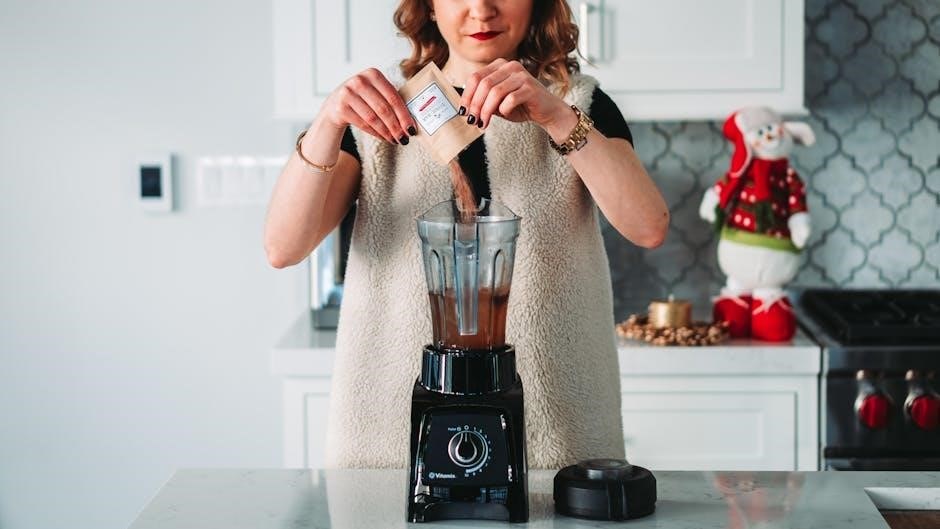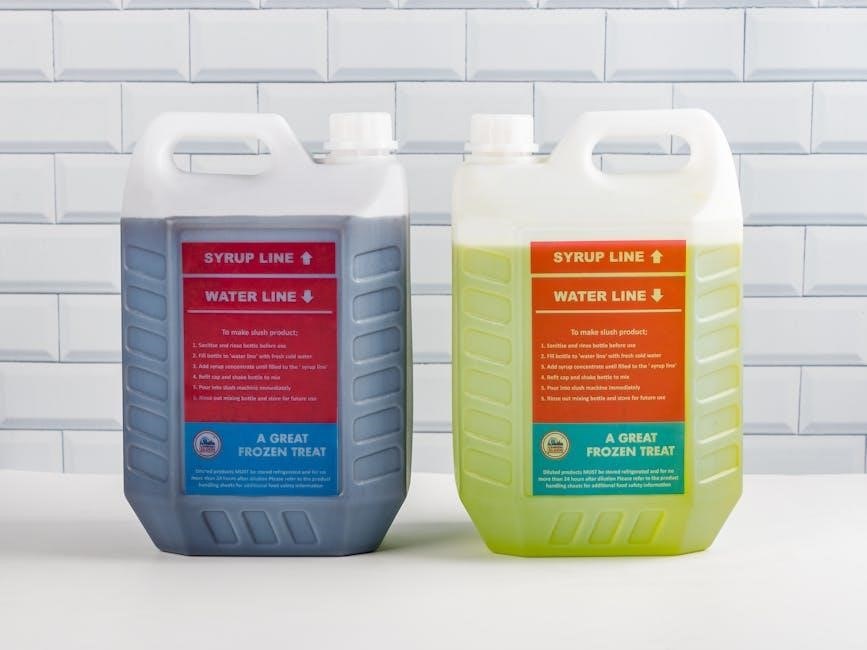Par 3 Herbicide is a widely used chemical for effective weed control․ Proper mixing and application are crucial for safety and efficiency․ This guide provides essential instructions and safety tips․

What is Par 3 Herbicide?
Par 3 Herbicide is a post-emergent herbicide used for controlling broadleaf weeds in lawns‚ gardens‚ and agricultural fields․ It contains dicamba as its active ingredient․
Definition and Uses
Par 3 Herbicide is a post-emergent herbicide designed to control broadleaf weeds in lawns‚ gardens‚ and agricultural fields․ Its active ingredient‚ dicamba‚ targets weeds like dandelions‚ clover‚ and plantain․ It is commonly used in residential and commercial areas to maintain weed-free landscapes․ Par 3 Herbicide is known for its selective action‚ meaning it primarily affects broadleaf weeds while leaving grasses unharmed․ It is often applied as part of integrated pest management strategies to ensure long-term weed control․ Proper application ensures effective results‚ making it a popular choice for both homeowners and professionals․ Its versatility and cost-effectiveness contribute to its widespread use in various settings․
Importance of Proper Mixing
Proper mixing of Par 3 Herbicide is essential for ensuring its effectiveness and safety․ Incorrect mixing can lead to reduced efficacy‚ potential damage to plants‚ or environmental contamination․ Accurate measurement and thorough agitation ensure the herbicide is evenly distributed in the water‚ maximizing its performance․ Proper mixing also prevents clogging of spray equipment and ensures consistent application rates․ Additionally‚ it minimizes the risk of over-application‚ which can harm desirable vegetation or contaminate soil and water․ Following the recommended mixing procedures guarantees optimal results while protecting the environment and human health․ Proper mixing is a critical step in achieving successful weed control and maintaining safety standards․

Safety Precautions
Handling Par 3 Herbicide requires strict adherence to safety guidelines to prevent exposure and environmental harm․ Always wear PPE and ensure a well-ventilated mixing area․
Personal Protective Equipment (PPE)
Wearing appropriate PPE is essential when handling Par 3 Herbicide to minimize exposure risks․ This includes long-sleeved shirts‚ pants‚ chemical-resistant gloves‚ and closed-toe shoes․ Eye protection‚ such as goggles or safety glasses‚ is mandatory to prevent chemical splashes․ A face mask or respirator should be used to avoid inhaling vapors or particles․ Ensure all PPE fits properly and is free from tears or damage․ Avoid wearing loose clothing that could get caught in equipment․ After use‚ wash reusable PPE thoroughly with soap and water․ Properly dispose of any single-use items․ Always follow the manufacturer’s guidelines for PPE use and maintenance to ensure maximum protection․
Safe Mixing Environment
A safe mixing environment is critical to prevent accidents and ensure effective herbicide preparation․ Choose a well-ventilated area‚ protected from wind‚ rain‚ and direct sunlight․ Avoid mixing near open flames‚ sparks‚ or sources of ignition․ Ensure the area is clear of clutter and tripping hazards․ Use a dedicated mixing zone to prevent cross-contamination with other chemicals or water sources․ Keep the area accessible only to authorized personnel․ Have spill cleanup materials nearby‚ such as absorbent pads or neutralizing agents․ Avoid mixing in areas where livestock‚ pets‚ or wildlife may be present․ Maintain a safe distance from water bodies‚ such as ponds or irrigation channels‚ to prevent accidental contamination․ Properly secure the area to prevent unauthorized access during and after mixing․
Handling Precautions
When handling Par 3 Herbicide‚ prioritize safety to minimize risks․ Always wear Personal Protective Equipment (PPE)‚ including gloves‚ goggles‚ and a face mask‚ to prevent skin and eye contact․ Avoid eating‚ drinking‚ or smoking while handling the herbicide․ Keep the product away from open flames or sparks‚ as it may be flammable․ Use a clean‚ dry scoop or measuring device to prevent contamination․ If spills occur‚ contain them immediately using absorbent materials and neutralize with soil or sand․ Avoid breathing in dust or vapors during handling․ Wash hands thoroughly with soap and water after use․ Store the herbicide in its original container‚ tightly sealed‚ and out of reach of children and pets․ Dispose of empty containers according to local regulations․ In case of accidental exposure‚ rinse affected areas with water and seek medical attention if irritation persists․

Mixing Instructions
Follow precise steps to mix Par 3 Herbicide safely and effectively․ Gather equipment‚ measure accurately‚ add to water‚ agitate thoroughly‚ and ensure proper timing for optimal results․
Gather Necessary Equipment
To ensure safe and effective mixing of Par 3 Herbicide‚ gather all required equipment beforehand․ This includes a clean water source‚ a calibrated measuring cup‚ a spray tank‚ and agitation tools like paddles or mechanical agitators․ Additionally‚ have personal protective equipment (PPE) ready‚ such as gloves‚ goggles‚ and a mask․ Ensure the spray tank is clean and free from residues of other chemicals․ A stir stick or mixing paddle is essential for proper agitation․ If using a mechanical sprayer‚ check that all nozzles and hoses are in good condition․ Having a rinse bucket and water source nearby is also recommended for cleaning equipment․ Proper preparation of equipment minimizes risks and ensures accurate herbicide application․ Always follow manufacturer guidelines for equipment compatibility and safety․
Measure the Herbicide
Accurate measurement of Par 3 Herbicide is critical for effective weed control and safety․ Use a calibrated measuring cup or scale to measure the recommended dose․ Avoid overfilling or spilling by pouring slowly and carefully․ Always refer to the product label for specific rates based on the target area and weed type․ Double-check measurements to prevent under-application‚ which may reduce efficacy‚ or over-application‚ which could harm plants or the environment․ If using a scale‚ ensure it is zeroed before measuring․ Wear protective gloves and goggles during this step to minimize exposure․ Proper measurement ensures the herbicide is applied safely and effectively‚ adhering to label instructions and environmental guidelines․ Never estimate quantities‚ as this can lead to inaccurate mixing and potential hazards․
Add Herbicide to Water
Add the measured Par 3 Herbicide to the water in the spray tank․ Ensure the tank is filled with the recommended amount of water before adding the herbicide․ Avoid overfilling to prevent spills․ Slowly pour the herbicide into the water while maintaining gentle agitation to promote even distribution․ Wear protective gloves and goggles to minimize skin and eye exposure; Do not add water to the herbicide‚ as this can cause uneven mixing․ Once added‚ secure the tank lid tightly to prevent leakage․ This step is critical for ensuring the herbicide is evenly distributed and effective․ Proper mixing prevents uneven application and potential environmental contamination․ Always follow the label instructions for the correct order of mixing to maintain safety and efficacy․ This step is essential for achieving optimal results with Par 3 Herbicide․
Agitation Process
After adding the Par 3 Herbicide to water‚ ensure continuous agitation of the mixture․ Use a mechanical agitator or recirculation pump to maintain a uniform solution․ Agitation prevents settling of the herbicide‚ ensuring even distribution․ Avoid stopping agitation during mixing or application‚ as this can lead to uneven concentration․ If the spray tank is refilled or left unused for an extended period‚ agitate the mixture again before resuming application․ Proper agitation is critical for maintaining the effectiveness of the herbicide and preventing clogged nozzles․ Always follow the manufacturer’s recommendations for agitation duration and method․ This step ensures the herbicide remains well-mixed and ready for application․ Regular agitation also helps prevent settling and maintains the product’s potency․ Proper mixing and agitation are essential for achieving desired results with Par 3 Herbicide․
Timing of Mixing
Timing is critical when mixing Par 3 Herbicide to ensure optimal performance and safety․ Mix the herbicide just before application to prevent settling or degradation․ Avoid mixing too far in advance‚ as this can lead to reduced efficacy or equipment clogging․ If delays occur‚ re-agitate the mixture thoroughly before use․ Always mix during calm conditions to minimize drift and ensure accurate application․ Follow the product label for specific timing recommendations‚ as environmental factors like temperature and humidity may affect the mixing process․ Proper timing ensures the herbicide remains effective and safe to use․ Never mix Par 3 Herbicide during extreme weather conditions‚ as this can compromise the solution’s stability․ Adhere to the recommended mixing schedule to achieve the best results․

Application Instructions
Proper application techniques ensure effective weed control․ Apply Par 3 Herbicide evenly‚ following recommended rates․ Use spraying methods for uniform coverage․ Apply during calm weather‚ avoiding strong winds or rain․ Optimal timing is early morning or late evening․ Maintain the recommended dilution ratio for best results․ Always refer to the product label for specific application guidelines to ensure safety and efficacy․

Timing of Application
Proper timing is critical for effective herbicide application․ Apply Par 3 Herbicide during early morning or late evening to minimize drift and ensure optimal absorption․ Avoid spraying during strong winds‚ heavy rain‚ or extreme temperatures‚ as this can reduce efficacy․ Ideal conditions include calm weather with temperatures between 60°F and 85°F․ Apply when weeds are actively growing‚ typically during the vegetative stage․ Avoid spraying when plants are under stress from drought or excessive moisture․ Ensure the herbicide dries completely on foliage before any rainfall or irrigation․ Timing also depends on the target weed species and growth stage․ Always consult the product label for specific recommendations tailored to your situation․ Proper timing enhances results and minimizes environmental impact․
Application Methods
Par 3 Herbicide can be applied using various methods to ensure effective weed control․ Broadcast spraying is the most common‚ covering large areas uniformly․ Spot treatment targets specific weeds‚ reducing chemical use․ Banding applies the herbicide in strips over rows‚ ideal for row crops․ Aerial application is suitable for vast areas but requires specialized equipment․ Ground equipment like boom sprayers or backpack sprayers is widely used for precision․ Always follow the product label for specific guidance on application methods․ Ensure proper nozzle selection and spray pressure to achieve even coverage․ Avoid overlapping spray patterns to prevent over-application․ Calibrate equipment regularly for accurate application rates․ Proper application methods maximize efficacy and minimize environmental impact․ Adhere to recommended practices for optimal results․
Recommended Rates
The recommended application rate for Par 3 Herbicide varies based on weed type‚ growth stage‚ and soil conditions․ Typically‚ rates range from 1 to 2 pints per acre‚ depending on the target species․ For broadleaf weeds‚ higher rates may be necessary‚ while grassy weeds often require lower concentrations․ Always refer to the product label for specific recommendations․ Weed density‚ size‚ and resistance also influence the required rate․ Soil type and moisture levels can affect herbicide performance‚ so adjustments may be needed․ Over-application can lead to environmental concerns and potential crop damage․ Under-application may result in reduced efficacy․ Consult local guidelines and the product label to ensure proper usage․ Adhering to recommended rates ensures effective weed control while minimizing risks to the environment and non-target plants․
Weather Conditions
Weather conditions play a critical role in the effective application of Par 3 Herbicide․ Avoid applying the herbicide during heavy rain‚ as it may lead to runoff and reduced efficacy․ High temperatures can increase evaporation‚ while low temperatures may slow herbicide activity․ Windy conditions should be avoided to prevent drift onto non-target areas․ Ideal conditions include moderate temperatures (50°F to 85°F) and minimal wind․ Apply the herbicide when no rain is forecasted for at least 24 hours to ensure proper absorption․ Avoid spraying during fog or mist‚ as it can reduce coverage․ Always check the product label for specific weather-related guidelines․ Proper timing based on weather ensures optimal results and minimizes environmental impact․ Adverse weather can compromise herbicide performance‚ so plan applications carefully․

Troubleshooting Common Issues
Common mixing issues include improper herbicide-to-water ratios and inadequate agitation․ Solutions involve recalibrating measurements and ensuring thorough mixing to maintain effectiveness and prevent equipment clogs․
Common Mixing Problems
When mixing Par 3 Herbicide‚ common issues arise from incorrect measurements‚ inadequate agitation‚ or improper water quality․ Over- or under-dosing can reduce effectiveness or harm plants․ Insufficient mixing leads to uneven distribution‚ while hard water or high pH levels can degrade the herbicide․ Additionally‚ using contaminated water or failing to follow temperature guidelines can affect performance․ Improper calibration of equipment and not following the recommended sequence for adding ingredients are also frequent mistakes․ These issues can result in poor weed control‚ environmental risks‚ or equipment damage․ Addressing these problems requires careful attention to instructions and routine checks during the mixing process․
Solutions to Mixing Issues
To address common mixing problems‚ ensure accurate measurements using calibrated equipment․ Use clean‚ soft water and maintain the recommended pH range․ Agitate the mixture thoroughly and continuously to prevent settling․ Avoid temperature extremes by mixing during cooler parts of the day․ Calibrate spray equipment regularly and follow the correct order of adding ingredients․ Double-check the label instructions for specific guidelines․ If using hard water‚ consider adding a water conditioner to optimize herbicide performance․ Regularly clean and maintain mixing equipment to prevent contamination․ Always follow the manufacturer’s recommendations for troubleshooting and adjust practices as needed to achieve consistent results․ Proper training and attention to detail can significantly reduce mixing errors and improve overall effectiveness․

Storage and Disposal
Store Par 3 Herbicide in its original container‚ in a cool‚ dry‚ well-ventilated area‚ out of reach of children and pets․ Dispose of unused product and empty containers according to local regulations‚ avoiding drainage systems․ Properly label and secure containers for disposal․ Always consult the product label for specific disposal instructions to ensure environmental safety and compliance with legal requirements․
Proper Storage Conditions
Par 3 Herbicide should be stored in its original container‚ tightly sealed‚ and kept in a cool‚ dry‚ well-ventilated area away from direct sunlight and heat sources․ Ensure the storage location is secure‚ inaccessible to children‚ pets‚ and unauthorized individuals․ The ideal temperature range for storage is between 40°F and 90°F (4°C and 32°C)․ Avoid storing the herbicide near flammable materials‚ fertilizers‚ or other chemicals․ Keep the container upright to prevent leakage․ Regularly inspect the container for signs of damage‚ corrosion‚ or wear․ Do not store the herbicide in areas prone to flooding or moisture accumulation․ Always follow the product label’s specific storage recommendations to maintain product integrity and safety․
Disposal Methods
Proper disposal of Par 3 Herbicide is essential to protect the environment and comply with regulations․ Always follow the product label and local guidelines for disposal․ Empty containers should be triple-rinsed and recycled or disposed of as hazardous waste․ Partially filled containers must be disposed of as hazardous waste and not reused․ Do not pour unused herbicide down drains‚ sewers‚ or waterways‚ as this can contaminate water sources․ Avoid mixing the herbicide with other chemicals or waste․ Check with local authorities for designated hazardous waste collection facilities․ Improper disposal can lead to environmental contamination and legal consequences․ Ensure all disposal methods align with federal‚ state‚ and local regulations to maintain environmental safety and responsibility․

Regulatory Compliance
Regulatory compliance ensures adherence to local‚ state‚ and federal laws when using Par 3 Herbicide․ Proper record-keeping and adherence to safety standards are mandatory․
Local Regulations
Local regulations for Par 3 Herbicide use vary by region and are enforced by local authorities․ These rules ensure safe application and environmental protection․ Key points include permitted usage areas‚ required permits‚ and restrictions on application timing․ Additionally‚ some regions may have specific guidelines for waterway proximity or sensitive ecosystems․ It is essential to consult local agricultural or environmental agencies before use․ Non-compliance can result in fines or legal action․ Always verify the latest updates‚ as regulations may change․ Proper adherence to local laws helps maintain both efficacy and safety․ Remember‚ local regulations are designed to protect public health and the environment while ensuring the herbicide’s effective performance․ Compliance is a shared responsibility for all users․
Record-Keeping Requirements
Accurate record-keeping is essential when using Par 3 Herbicide․ Maintain detailed logs of application dates‚ locations‚ product amounts‚ and rates․ Record environmental conditions‚ such as weather and soil type․ This documentation ensures compliance with regulations and provides traceability․ Keep records for a minimum of three years‚ as required by many agricultural standards․ Include details like equipment used and safety measures applied․ Digital tools or physical notebooks can be used for organization; Proper record-keeping aids in audits‚ traceability‚ and environmental safety․ It also helps track long-term herbicide performance and environmental impact․ Always ensure records are legible‚ complete‚ and securely stored․ This practice supports responsible herbicide management and demonstrates adherence to regulatory and environmental guidelines․

Environmental Considerations
Par 3 Herbicide can impact ecosystems if misused․ Prevent contamination of water sources and soil․ Follow guidelines to minimize environmental harm and protect wildlife habitats responsibly․
Environmental Impact
Par 3 Herbicide can pose risks to aquatic ecosystems and soil health if not used correctly․ Improper mixing or over-application may lead to water contamination through runoff or leaching․ This can harm aquatic life‚ including fish and other organisms‚ by altering water chemistry and reducing oxygen levels․ Soil contamination may affect microbial activity‚ potentially disrupting nutrient cycles and plant growth․ Wildlife‚ especially non-target species‚ may face indirect threats due to habitat changes․ It is crucial to follow recommended rates and safety guidelines to minimize these risks․ Proper handling and disposal are essential to protect the environment and maintain ecological balance․ Always prioritize responsible use to safeguard natural resources and biodiversity․
Protective Measures
To minimize environmental risks‚ implement protective measures when using Par 3 Herbicide․ Always wear recommended PPE‚ including gloves and eye protection‚ to prevent exposure․ Use closed mixing systems to reduce drift and ensure containers are tightly sealed․ Avoid mixing near water sources or during windy conditions to prevent accidental contamination․ Establish buffer zones around aquatic areas and sensitive ecosystems․ Regularly inspect equipment for leaks or damage to prevent unintended chemical release․ Dispose of leftover herbicide and rinse water according to local regulations․ Properly clean and maintain equipment to avoid residual contamination․ Train all users on safe handling practices to reduce environmental impact․ By adhering to these measures‚ you can help protect both human health and the environment while ensuring effective weed control․
Properly mixing and applying Par 3 Herbicide is essential for effective weed control while ensuring safety and environmental protection․ By following the guidelines outlined in this guide‚ users can achieve optimal results․ Always prioritize safety precautions‚ such as wearing PPE and mixing in a well-ventilated area․ Adherence to recommended rates and timing ensures both efficacy and environmental care․ Regularly inspect equipment‚ store the herbicide correctly‚ and dispose of waste responsibly․ Environmental considerations‚ like avoiding water sources and sensitive areas‚ are critical to minimizing ecological impact․ By carefully following these instructions and taking necessary precautions‚ users can successfully manage weeds while protecting themselves‚ others‚ and the environment․ Responsible use of Par 3 Herbicide ensures long-term effectiveness and sustainability․